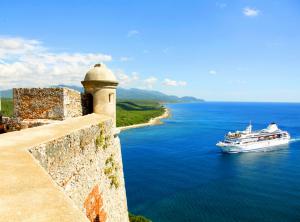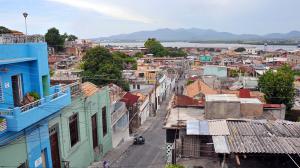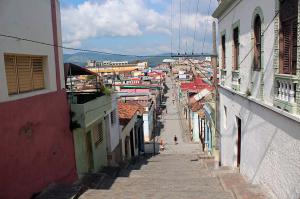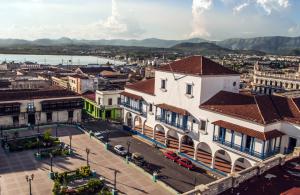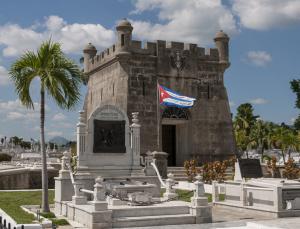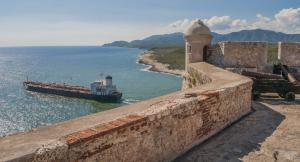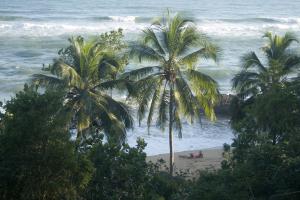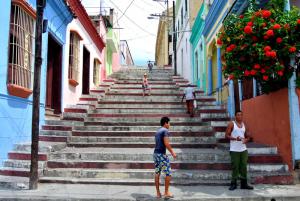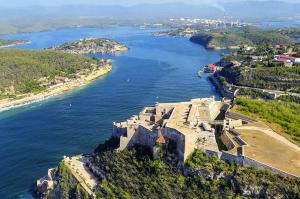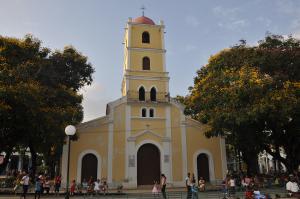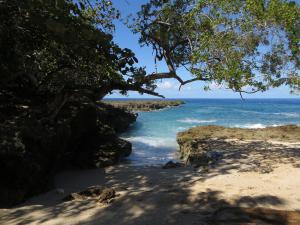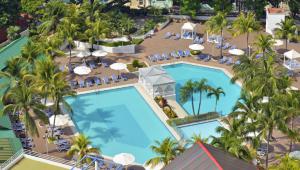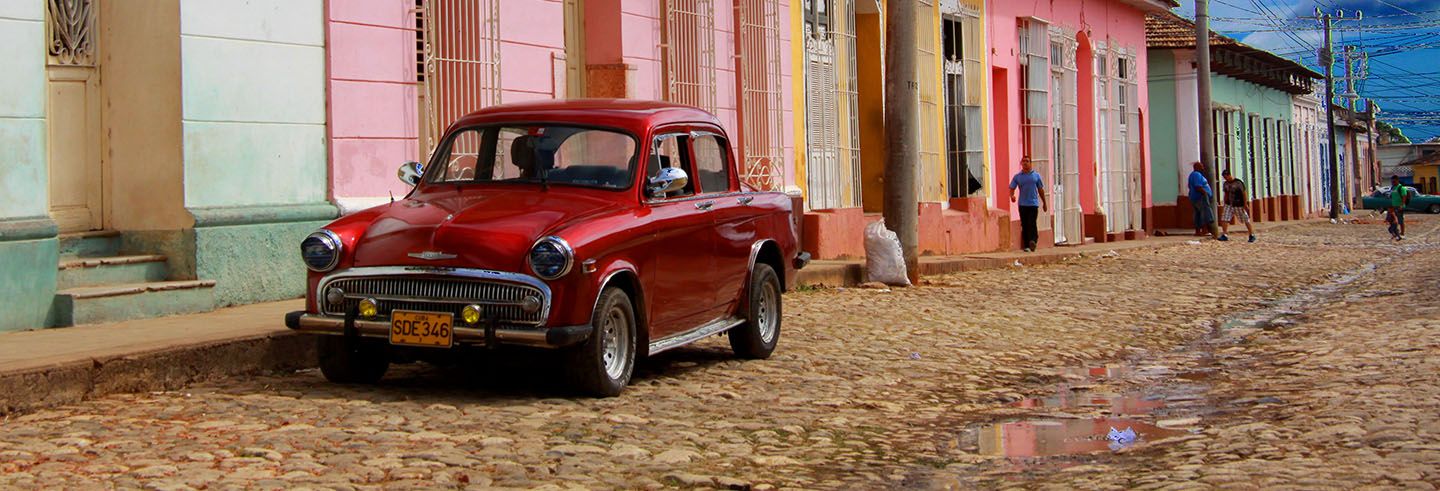

Santiago de Cuba
Come to Santiago de Cuba, be surprised by its patrimony and explore the place where the Cuban Revolution started
Santiago de Cuba is one of the most significant provinces in the country, located in the easternmost part of the country, it is one of the provinces with the most green areas and the most Caribbean of all. The province of Santiago is made up of nine municipalities, the largest and most important of which is the homonymous Santiago de Cuba, which is the capital. Other municipalities include Palma Soriano, the second most populated municipality, and Contramaestre, the third most populated municipality in the province.
Geographically, the Santiago province borders Granma to the west, Holguín to the north and Guantánamo province to the east. All of these provinces are bathed by the Caribbean Sea, through which the warm equatorial currents pass and because of this its waters have an warm temperature incredible for swimming at any season: an incredible pleasure.
The homonymous capital of this province was the first city to be founded, more to the point in 1515 by Diego Velázquez de Cuellar. After this, Santiago de Cuba was named capital of the country till 1556.
For this reason the city has an enormous cultural as well as historical patrimony, replete with emblematic monuments and buildings. On the other hand, its natural patrimony is something to envy, because of the presence of Sierra Maestra, which besides conditioning the climate of Santiago and making it very special within Cuba, is a practically unique ecosystem, represented mostly by ferns, palm trees and a great number of birds and amphibians: a true luxury.
The climate in Santiago is pretty hot, so bathing in the wonderful beaches that you will find here is a must, probably due to the Caribbean climate that this province enjoys, its inhabitants are full of happiness, pure partying and there are no worries for them. A destination where you will be welcomed with open arms, full of parties, great humour and a wonderful atmosphere.
The streets of this city are a delight to walk through, having a pleasant walk on them you will admire the happy spirit of the people of Santiago. The houses painted in bright and cheerful colours reflect the attitude and the way of being of locals, walking through this wonderful city is something that you will definitely love. Its architecture, where you can find different architectural styles, but being the Art Deco the most outstanding, due to this mixture of different architectural styles it is considered as a city of eclectic architecture.
Index
- What to see in Santiago de Cuba?
- What are the best plans to do?
- When to go to Santiago de Cuba?
- What are the best excursions?
- How to get to Santiago de Cuba?
- Where to stay?
What to see in Santiago de Cuba?
Santiago as a province, owns an enviable patrimony, full of attractions to see, from paradisiacal beaches, green and mountainous areas, monuments or historical and cultural patrimony.
In the westernmost part of the province near the border with Granma, you will find Pico Turquino, the highest point in all of Cuba and as a curiosity, the only point where a snowfall has been officially registered in the history of the country, more to the point in 1900. However, this is not the only tip in this area of the island. Thanks to Sierra Maestra, you will find a privileged ecosystem, the green areas with a pretty high level of endemism when it comes to flora and fauna where you can totally disconnect yourself and relax in the middle of nature and at an idyllic spot.
Only half an hour by car from the provincial capital we find the El Cobre village. In this small town you can admire the Basílica de Nuestra Señora de la Caridad del Cobre, known as La Cachita as well. It is the patron saint of Cuba and this is the place of pilgrimage par excellence in the country. The basilica, of eclectic style, is located on one of the highest points in the town, making it possible to admire it from different parts, emphasising especially its imposing centric tower.
On a nearby hill you can see the monument to the Cimarrón, erected in honour of the mining slaves of the 17th century. On your way up, you will have astonishing views of the Laguna Azul de El Cobre and the surrounding glorious natural spots. In the beginning of July, the Fiesta de los Cimarrones takes place in this town, mainly dances, songs and rituals are performed next to the monument, something that if you go there at that time you must see, as it is an amazing cultural spectacle.
At the beginning of the 19th century Cuba was the most important exporter of coffee beans in the world and in the province of Santiago de Cuba there is a big number of these coffee plantations which were declared a World Heritage Site in 2000 as Archaeological Landscape of the First Coffee Plantations of Cuba.
The most important coffee plantation in the area is La Isabelica, where you can observe the whole process surrounding the production of this globally popular product. Among everything you will see the buildings stand out, a two-storey mansion, nowadays converted into a museum, the furniture and the coffee drying sheds. The surroundings of this impressive place are the ideal setup for a nature excursion.
You can not leave this area without visiting its main attraction, La Gran Piedra, an enormous rock formation, weighing around 75,000 tons, which is the third largest rock in the world. Something so unique and unmissable. From the top you will have amazing views at an altitude of 1,225 metres and with a privileged ecosystem where you will find 222 different species of ferns and many other species of flora, such as pines and cypresses. When it comes to the fauna in the region, it is one of the striking ones. Let’s say the different bird species, like woodpecker birds or the tocororo (Cuban trogon), the national bird of Cuba due to the splendour of its plumage with the colours of the Cuban national flag.
Arriving at the capital, Santiago de Cuba, you will find a wide range of places to see, from monuments, to different emblematic buildings. As we are talking about the first capital in the country, a truly amazing cultural patrimony is guaranteed.
The key centre of the city is the Parque Cespedes (Cespedes Park). In this emblematic place you will discover the lovely and happy nature of local people. It is common at this square to meet people and carry out speeches and many social and cultural acts during the day.
This typical square in the centre of Santiago de Cuba is the perfect meeting point, in that place you will find the Casa de Diego Velázquez (Home of Diego Velázquez), founder of the city, this splendid house was the first one in all of Santiago. Nowadays it is the Museo de Ambiente Histórico (Historical Ambience Museum).
Right across the square we find the Catedral Basílica de Nuestra Señora de la Asunción and the Ayuntamiento de Santiago (Santiago Town Council), the church, of a baroque style was the first religious building in the town and when you are in front of it you will be amazed by its very typical towers and its two marble statues, one of them in honour of Christopher Columbus and the other in name of Padre de las Casas, known of its great defence of the American indigenous.
The Santiago Town Council, of colonial style, was founded by Diego Velázquez, although the current design belongs to Luis Caseiro, mayor during the 20th century. Since 1901, the Fiesta de la Bandera has taken place, the 31st of December each year, whilst the twelve chimes ring at the end of the year. At that moment the mayor raises a huge flag in honour of the first time the mayor removed the US flag and raised the Cuban one.
A few minutes walk away you will find the most emblematic street. Enramadas Street is the place where we find the majority of the shops in the city, with an amazing atmosphere, replete with shops and entertainment venues, such as bars and restaurants, cinemas or theatres. Without a doubt, a nice stroll down the street whilst seeing its shops and you are having a refreshing drink or some fresh fruit typical in the area, such as papaya or custard apple.
A few metres away we find the Balcón de Velázquez, where you will have the best views of the bay of Santiago, a lovely and gorgeous corners dating back to the middle of the 16th century as a method of protection due to its excellent location it was possible to control all the marine traffic in the area and thus have a great control over possible attacks on the city from the sea.
After these beautiful views, it is time to go through one of the most important and historic neighbourhoods of Santiago, El Tívoli. For that you have to climb to the Escalinata Padre Pico (Padre Pico Staircase), an important point in this city possessing a great fame, according to the people of Santiago, “if you have not climbed the staircase, you have not been to Santiago”. This means you have to climb these 52 steps and reach the Tívoli neighbourhood, but first you must go through the Museo de La Lucha Clandestina, which is a former police station that was assaulted by the activists of the revolutionary struggle. In this museum you can see an exhibition about these events, the struggle of Cuban activists for the revolution in their country, a place not to be missed as it is a clear example of the culture of Cuba.
Arriving in the El Tívoli neighbourhood you will find a splendid mixture of cultures, in this enclave Haitian immigrants settled here when fleeing from the difficult political situation in the neighbouring country. With them these immigrants brought workforce, customs, culture and made a place for themselves in Santiago, here actually, in the Tívoli neighbourhood. Having a nice walk through its steep paths you will see the genuine essence of this place, its architecture with tall houses facing the sea. It was here that the popular carnival of Santiago began thanks to the mixture of Haitian pagan celebrations and French ballroom dancing. Having a splendid walk through these streets is one of the most awesome things to do in Cuba, a place replete with splendour, different cultures and a lot of history: a must-see.
One of the most typical products in Cuba is rum, more to the point Santiago de Cuba is the birthplace of several of the most important brands in this sector. 20 minutes walk away we find the Museo del Ron (Museum of Rum). Here you encounter an extensive exhibition on the manufacturing process of this product, from the sugar cane to its bottling bit. This museum is a must on your trip to Santiago city, as it is not just a museum about a drink. It is Cuban culture and tradition in its most authentic form, a product that helped the national economy enormously. The country and the city are what they are thanks to rum export. This makes it a museum of Cuban and Santiago’s history.
In the heart of Santiago you find in a few street away the Plaza de Dolores (Dolores Square), the Iglesia de Nuestra Señora de los Dolores (Nuestra Señora de los Dolores Church) and the Palacio de Gobierno Provincial (Provincial Government Palace). This last one is the governmental seat of the Santiago de Cuba province and with an eclectic architecture it is the place where the political decisions of the entire province are administered. It is a building possessing grand significance and this is demonstrated by the sheer number of details it has, such as the luxurious marble staircases or the grand bronze statues found inside. On the outside we have the massive Corinthian columns giving this building a nice glorious touch.
In 1991 the Plaza de la Revolución was inaugurated in the northern part of Santiago, which is one of the main meeting points in the city. The square is mainly used for concerts and other popular acts, as the capacity is of 150,000 people approximately, besides you are able to admire the sculpture on horseback of General Antonio Maceo. He was a soldier who fought for the freedom of the Cuban territory in the 19th century, who was nicknamed “El Titán de Bronce” (The Bronze Titan). Additionally, in this very place there are many rooms, one of them with exhibitions of different documents and images about General Maceo and another room that is used for scientific exhibitions.
More to the point, one of the most astonishing cemeteries in the world is in Santiago. The cemetery of Santa Ifigenia was opened in 1868 and holds the remains of many Cuba’s brightest figures, such as José Martí, the creator of the Cuban Revolutionary Party rests in his own mausoleum, shaped like a hexagonal tower and a moat inside with a sculpture of Martí. This is a splendid place, a must on your visit to Santiago, as it will leave you astounded.
The aforementioned cemetery is not only home to the remains of José Martí, but Fidel Castro is likely the most famous and one of the most significant figures in the Cuban history. In 2016, the former Cuban Prime Minister died and after being cremated, his remains were laid to rest in this very cemetery, in a huge rock about 4 metres high and weighing around 50 tons. Without a doubt, this spot is a must, as it has an aura of mysticism attracting you due to the amazing tombs that you can find in this cemetery and the significant people that lie in this place.
Just off the coast of this city we find one of the best-kept fortresses in the world, declared a World Heritage Site in 1997. The Castillo de San Pedro de la Roca del Morro is an ancient military fortress built in 1638 in order to find all threats coming from the sea and to protect the Santiago bay if necessary. Nowadays it is one of the biggest and best-kept fortifications in the world. Thanks to its location you will have one of the best views of the city, the Santiago bay falls at the feet of the fortress that can be seen entirely. In the background the Caribbean Sea can be seen in its amazing amplitude till it joins the sky creating a thin line.
The fortress can be accessed by crossing a wooden bridge and just below a moat created to surround it with water and prevent access to it. Once you are inside you can explore all the secrets of 17th century piracy from the weapons they used to the different cannons and ammunition used to shoot down enemy ships and prevent their access to the island. The museum is not the only place in the castle where there are cannons. In the olden days they were located in the artillery area where you can still find them pointing out to the sea to be alert to the arrival of enemy ships.
If these enemies were captured, they were locked up in the dungeons of the fortress, which you can enter and discover the conditions in which the pirates who were captured and brought here spent days and even months. How many things must have happened in these cells? The mystery takes hold of them and will make your imagination run wild.
You can not leave this magnificence of 17th century military architecture without climbing to the top and appreciating the sunset, which is glorious, an opportunity that you can not have in every destination, being on top of a castle on the coast of Santiago de Cuba whilst the sun meets the Caribbean Sea. Without a doubt, a particular and remarkable thing to enjoy during your visit to such a marvellous city.
What are the best plans to do in Santiago de Cuba?
In the intriguing province of Santiago de Cuba we find important cultural heritage, such as the ancient capital of the country, you will get to meet its lovely people with who you will spend great time dancing salsa or son cubano and its nature that invites you to explore all its corners, all its natural parks, beaches, mountains and the glorious Cayo Granma possessing Cuban traditions 100%.
The nature in Santiago province is perfect for different activities during your stay on the island. In this case, the wide range of green areas in the province make this the idyllic place for nice walks, horse or bike rides, different activities you can do in this area to admire the immense nature and have a moment just for yourself.
The Sierra Maestra crossing the entire province from one side to another is a great place to stop and do this sort of activity thanks to the sheer number of national as well as natural parks at your disposal. Additionally, these spots are perfect not only for nice walks, but observing birds is one of the most splendid things to do in this part of Cuba thanks to the many species available here. Although bird-watching is possible all over the Sierra Maestra, the most popular place to do it in this mountain range is La Gran Roca, a high area with lots of trees where you will be able to eye many species whilst tasting some of Cuba’s best products, like its tasty fruits, including custard apples and yummy guavas in an iconic atmosphere.
Near the border with Guantánamo province we find the Parque Baconao (Baconao Park) in this place named a World Biosphere Reserve by UNESCO. A must-see attraction on your visit to Santiago. It has different areas, each with its own lovely charm. At the Baconao Lagoon you will have the opportunity to go sport fishing, take a boat ride and go on a fun-filled water bike ride, where kids and adults will have a great time.
The perfect place for the kids is the prehistory valley, there they will feel as if they were in the Jurassic Park film thanks to the life-size figures of different species of dinosaurs, sabre-toothed tigers or mammoths. Without a doubt, it is one of the most surprising and funniest places in Cuba where kids and adults can take pictures with their favourite prehistoric species and have an unforgettable one of a kind souvenir.
Besides enjoying extinct species, you will have the opportunity to observe the most beautiful aquatic animals in the aquarium available in the area. This has a shark tank, where you will see the largest predator of the ocean above you whilst crossing a glass tunnel where they are. Truly an amazing experience. Additionally, you have a fish tank room where you discover many saltwater as well as freshwater species. The party piece of this aquarium is the dolphin and sea lion shows, which amaze people every time with their skills.
Heading towards the city of Santiago you find the Jardín de los Helechos (Fern Garden), an astonishing botanical garden of around 3,000 square metres specialised in this type of plant, this splendid place has approximately 3,000 different plants. It is truly worth a visit on your way to the city and browse the vegetation, which is gorgeous by the way.
In the provincial capital you have an endless number of activities at your disposal, mainly, it is a city with splendid streets to walk around and it is the first thing you should not miss. The wide streets of this city are an enviable attraction due to its lovely eclectic architecture, its houses painted in very happy colours representing the good sense of humour of locals and the ideal sunny climate of the area, inviting you to explore the city on foot and at times relax with a delicious mojito on a terrace whilst listening to a nice Cuban son by the local singer Comay Segundo in the background. Definitely a holiday in the most genuine Caribbean style.
To move between places too far away to go on foot, you have ways of transport to choose from. The most typical being the coco taxi, a very distinctive and amusing mode of transport. It is a kind of motorbike with two back seats for passengers and a half-covered top. If you swing by Santiago you have to take the coco taxi at least once. Apart from the normal buses and taxis there is the horse, which can be great fun. Also, the bicitaxi (cycle rickshaw) to enjoy a ride under the Caribbean sun or even to move around in a classic American set of wheels as if you were in a film from the 60s. This is honestly a great experience if you are a car enthusiast. You will enjoy it greatly.
Cuba is synonymous with music, happiness and a good atmosphere, so do not let the chance to visit the Casa de la Trova (Trova House) go past. There you can enjoy the best performances of typical Cuban music, while having a mojito or a daiquiri. This shop is located on Calle Heredia, the liveliest street in the entire city where many people gather at all hours of the day to live the experience that is the true Cuban essence. Come here and enjoy the warm atmosphere and the joy of the locals to the rhythm of the best Caribbean music.
Of course, being in a Caribbean city, there is no lack of water activities. The Caribbean Sea has a huge abundance of marine life, so snorkelling and scuba diving in temperate waters like these is a must on your visit to Santiago and its coasts. To this we have to add the number of sunken ships found on the shores of this city, this fact makes diving activities to eye these ships have a nice inherent mystery. Are you going to miss such a great activity? Its calm currents also make a boat trip in the bay so nice and calmful that you will not want to miss it.
When to go to Santiago de Cuba?
Santiago is a destination to visit at any season thanks to its pleasant weather, although the best months to visit tend to be from November to April, coinciding with the coolest season.
The best festival not only in Santiago, but in Cuba is its carnival, the best known in the entire country. Normally it is held at the end of July. During these days music, colours and joy take over the streets of the capital of Santiago. Music groups, parades, dances and tasty food is what you will find in Santiago during these dates, making it an opportunity you will not want to miss for anything in the world.
Additionally, in the beginning of the same month the La Fiesta del Fuego on the occasion of the Festival del Caribe. For two weeks, many towns in the province of Santiago de Cuba will be full of festivities and celebrations, for example in El Cobre, the celebrations in honour of the Cimarrón, you could say that July is the month for celebrations.
What are the best excursions in Santiago de Cuba?
The sheer size of the province, the number of kilometres of coastline and the number of natural parks means there are plenty of excursions throughout the area from beaches to cays to tropical rainforests.
The province has four National Parks and a Biosphere Reserve. To the west is the Sierra Maestra and the Turquino National Park. To the north, shared with the Holguín province you find La Mensura and Pico Cristal. The first one of them is made up of mountains, forests, an impressive waterfall like the Salto del Guayabo 127 metres tall divided into two falls, the last one of 87 metres, a beauty to see a waterfall from that height in such a marvellous environment. After the waterfall, you have to walk along the La Sabina trail till you reach Las Pozas de Rafael, a lovely lagoon for relaxation and a refreshing bath after a good hike.
As for the Parque Nacional de Pico Cristal (Pico Cristal National Park), a privileged ecosystem with an enormous number of animal and plant species, in its interior you will find different villages such as, El Palenque, small and very rural, dedicated especially to the harvest of coffee beans. In these small villages the tradition is well alive so they are a great attraction as well.
The other big park in this province is Gran Piedra, which is famous for having one of the biggest rocks in the world. An idyllic place for excursions, picnics and many other activities. Also, in this place you find most of the coffee plantations in Santiago de Cuba, an opportunity to visit as many as you can and get to know a big part of the patrimony and history of Cuba. The Baconao Park, with its different areas and activities is a one of a kind place for day trips. You can admire its green meadows, its life-size dinosaur figures, its aquarium and its lovely lagoon. An unmissable place in this paradise.
In the Santiago de Cuba bay, you will find a small island, Cayo Granma, inhabited by families of fishers, in the center, there is a small church, and it is a wonderful place since the tradition belongs intact. The families live off of the fish they catch, products taken from the sea, and always respect the environment. This cayo, or small island, can be reached by a ferry, pass through the traditional streets, and enjoy their rich cuisine from the sea while having a beer and watching the sunset.
One of the biggest attractions of Santiago, as is normal for a destination in the middle of the caribbean sea, are its beaches. This province has a large quantity of swimming areas, among the most outstanding for its beauty and uniqueness are Siboney, the closest of them all. It belongs to a village with the same name and the beach has thick, light colored sand, with some palm trees. It stands out above all for being very close to the capital, just about 14 kilometers away.
Daiquiri isn’t just a gorgeous beach, where you go from a lush grove to being in the middle of an incredible white sand beach perfect for swimming. It is also a place with plenty of history. This is an important area in the iron mining industry of Cuba, and in addition, the famous cocktail has its name because it is said to be created here, in the same mines where they extract the iron. An engineer, when the gin ran out, made the same drink adding cuban rum and a little sugar to reduce the strong flavor of this liquor and thus, the daiquiri was born.
Near the border of Guantanamo, you will find one of the best beaches in the entire zone, Playa Cazonal. With soft, white sand, and crystal clear water, it is the perfect place to spend the day taking in the sun and cooling off in the waters of the Caribbean Sea. With the large amount of vegetation at the entrance of the beach you can use for shade you will 100% be fully relaxed and disconnected from everything. You can’t miss out on this beach.
The excursions Jeep Experience in Cuba are very common and are an activity you must do. Not only are they incredibly entertaining, it is also a great opportunity to see the nature of the area from points that are not accessible otherwise. Due to the large number of natural attractions in this province, it is possible to do this excursion on multiple routes, from the Turquino National Park, to the Gran Piedra, or “Great Rock”. On the other hand, many of them do not focus only on showing you the landscapes of Santiago, they also tell you the stories of each point you pass through. Highly recommended.
Very close to Santiago, an hour and a half in car, you will find the city of Guantánamo, famous for its bay and having one of the most isolated prisons in the world. Beyond that,, Guantánamo is a city worth visiting, with many beaches quite close to have a nice dip in the Caribbean. In addition, their streets are filled with people and a good atmosphere. In this city, you should see, among other things, The Cathedral of Santa Catalina of Riccis. It has a very simple style, with three doors in the front of it, a central tower, and bell tower. Right in front of the cathedral you will find the central park of the city, Martí Park offers a beautiful view of the cathedral and is ideal for hanging out under the shade of the trees.
In the other direction, a good 2 hours in the car, you will find the city of Bayamo, the capital of the province of Granma where you can see the full essence of the cuban tradition. Although, it will be difficult to see a colonial building since after a failed liberation attempt against spanish colonialism, they set the city on fire, thus avoiding any type of occupation. This fire consumed practically all of the colonial buildings, reducing them to almost none. Still, there are many things to see, like the cathedral of Our Lady of Immaculate Conception, a cathedral with two towers, one taller than the other that gives it a special touch. The Paseo Bayamés is probably one of the most beautiful streets in Cuba. Along the street you will find murals on the facades and even on the ground as well. You will not want to miss something so beautiful.
How to get to Santiago de Cuba?
The city of Santiago, has its own airport, very close to the center. This makes getting there very simple. The Antonio Maceo y Grajales International Airport has direct connections with Paris, Rome or Madrid. Once you’re in the airport, you're only a 10 minute car ride away from the city.
On the other hand, the Frank País International Airport, situated in the city of Holguín, has connections to Moscow, Frankfurt, Amsterdam, Milan or Toronto. From this airport, you will be a 2 hour car ride from the city of Santiago de Cuba.
Where to stay in Santiago de Cuba?
On your trip to Santiago de Cuba, you will find many options for lodging. They all have something in common: the comfort and the charm that they offer, making you feel at home, as well as having unbeatable prices.
If you are looking to stay in a hotel in the heart of the city, the Cubanacan Casa Grande is perfect for you. A cozy 4 star hotel in the heart of the city and a 20 minute walk to the train station, with a multitude of services such as room service, two bars, a restaurant, free wifi, and sales of entrances to tourist attractions in the city that will make your stay more comfortable.
If you are looking to relax and disconnect from the routine during your vacation, the Meliá Santiago de Cuba will surprise you. A luxurious 5 star hotel, located near the historic center of the city in which you can enjoy the impressive views of the Sierra Maestra thanks to the large windows in the rooms. Among the wide range of services the hotel has to offer, the exquisite cuisine that adapts to all tastes stands out. It also includes a large room where you can enjoy a cocktail while listening to live music, a gym, and a large swimming pool.
In the Hotel Iberostar Heritage Casa Granda 4 starts, located next to the Parque Céspedes, you will stay in a historic colonial that dates back to 1914, located just 1 minute from emblematic places such as the museum of Diego Velázquez, with an unmatched decoration with all kinds of details. Enjoy a cozy atmosphere in which personalized attention to customers prevails, 3 restaurant areas with dishes from around the world and a roof terrace from which you can enjoy beautiful views of the city of Santiago.
If, on the other hand, you want to stay in a more quiet and cozy space, you will love The Hostal Girasol. In the historic center of the city, maintaining the true essence of the Cuban people, with a close treatment like family, you will feel right at home. This hostal stands out for the kindness of its hosts, who will make your stay a beautiful memory, offering food services that highlight the gastronomic tradition. At The Sunflower Roof Garden you can have delicious typical drinks and take beautiful pictures of the city worthy of a postcard. Here you will also find free wifi, pets allowed, transport to the airport and room service.
If you are travelling as a family, don’t pass up the opportunity to stay at the 3 Star Hotel Cubanacan Versalles, located just a 7 minute car ride from the city center of Santiago de Cuba and only 8 minutes from the airport.
This hotel, which stands out for its great historical-cultural offer for its clients, will offer you the opportunity to enjoy a traditional festival in the Caribbean. This festival shows its rich culture and gastronomy, having a daily variety of itineraries for families, as well as a ride range of entertaining activities throughout the day. They are suitable for all ages and guarantee that you won’t get bored. All of the rooms, completely decorated, have free wifi, room service, massage service that will make you disconnect completely, and a grand open air swimming pool.
Interactive map:
Santiago de Cuba
What to see:
- Santiago de Cuba Cathedral
- Parque Céspedes (Céspedes Park)
- Ayuntamiento (City Hall)
- Balcón de Velázquez (Balcony of Velázquez)
- Iglesia de Nuestra Señora del Carmen (Church)
- Iglesia de San Francisco (San Francisco Church)
- Casa del Estudiante de la Trova
- Palacio de Gobierno Provincial (Gobierno Provincial Palace)
- Pasos Padre Pico
- Plaza de Dolores
- Iglesia de Nuestra Señora de los Dolores (Church)
- Plaza de Marte
- Tivoli
- Parque Alameda
- Fábrica de Tabacos César Escalante (César Escalante Cigar Factory)
- Iglesia de Santo Tomás (Santo Tomás Church)
- Cuartel Moncada
- Abel Santamaría Historical Complex
- Palacio de Justicia (Palace of Justice)
- Vista Alegre
- African Cultural Center "Fernando Ortiz"
- Palacio de Pioneros (Palace)
- Parque Zoológico (Santiago de Cuba Zoo)
- Cementerio Santa Ifigenia (Santa Ifigenia Cemetery)
- Loma de San Juan
- Castillo de San Pedro del Morro (Castle)
- Cayo Granma
- Ermita de San Rafael (San Rafael Chapel)
- Caleta La Estrella
- Jardín de los Helechos (Fern garden)
- Calle de la Santería (Santeria street)
- Casa de las Tradiciones (House of Traditions)
- Puerto Boniato
- Real Cárcel de Santiago de Cuba (The Royal Jail)
Museums:
- Museo del Ron (Ron Museum)
- Museo de la Lucha Clandestina
- Museo del Carnaval (Carnaval Museum)
- Museo Municipal Emilio Bacardí Moreau (Provincial Museum Emilio Bacardí Moreau)
- Casa del Caribe (Caribbean House)
- Museo de Imagen (Image Museum)
- Museo de la piratería (Piracy Museum)
- Casa Museo de Frank y Josue País (Frank and Josue País House Museum)
- Museo Casa Natal de Antonio Maceo (Antonio Maceo Birthplace Museum)
- Museo Tomás Romay (Tomás Romay Museum)
- Casa Natal de José María de Heredia (Birthplace of José María de Heredia)
- Museo Arquidiocesano (Archdiocesan Museum)
- Casa De Diego Velázquez
- Casa de la Cultura Miguel Matamororos (House of Culture Miguel Matamoros)
Parque Baconao (Baconao Park)
- La Gran Piedra
- Cafetal La Isabelica
- Baconao Aquarium
- Prado de las Esculturas
- Botanical Garden of Santiago de Cuba
- Valle de la Prehistoria
- Los Mamoncillos Artistic Communities
- Museum of Natural History
- Museo Nacional de Transporte Terrestre (National Museum of Land Transport)
- Mesoamerican Exhibition
- Laguna Baconao (Baconao Lagoon)
- Playa Cazonal (Cazonal Beach)
- Playa Daiquiri (Daiquiri Beach)
- Playa Baconao (Baconao Beach)
Other nearby destinations:
Why "Cuban Travel Agency"?
"Cuban Travel Agency" is part of the Visitar Cuba project, an organization of Cuban agencies whose objectives are:
- ✓ Disseminate Cuba, its culture and its heritage.
- ✓ Promote sustainable tourism.
- ✓ Support the local economy, prioritizing direct contact with Cuban agencies.
- ✓ Offer budgets without commitment and without cost, from the hand of Cuban experts.
Travel agencies and Tour Operators
If you are an agency or tour operator and you are looking for help to create trips to Cuba, trust our expert hands, we offer special prices.
© www.CubanTravelAgency.Org - All rights reserved.



